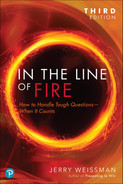Chapter One
The High Stakes of Q&A
Case Studies: The IPO Roadshow Study • The Kennedy–Nixon Debate • Tony Hayward, BP
To be, or not to be, that is the question.1
Hamlet
William Shakespeare
■ The Pricing of an IPO ■
When companies offer shares to the public for the first time, the firm’s senior management team develops and delivers an IPO roadshow, a subject you’ll read more about in the next chapter. For now, let me say that this type of presentation ranks very close to the top in the rarefied hierarchy of high-stakes events. These offerings seek to raise hundreds of millions, and sometimes billions, of dollars in the stock market. Investors are limited to buying only a ten percent tranche of the total offering, a commitment that can represent tens if not hundreds of millions of dollars—all riding on how investors perceive the roadshow, and its requisite Q&A session.
A revealing academic study called “Perceptions and Price: Evidence from CEO Presentations at IPO Roadshows,” which was conducted by the business schools of three major universities, examined “how investor perceptions of management influence firm valuation.”2
The Wall Street Journal reported on the study and went right to the bottom line in its article:
They found that perceptions of the CEO are a strong predictor of an IPO’s price. The study found that, for the average CEO, a 5% higher rating on perceptions correlated to an IPO price roughly 11% higher than the price that would be expected based on fundamentals alone.3
Just as perceptions can be predictors of prices in business, perceptions can also be predictors of political success—particularly in the high-stakes events of presidential debates.
■ The Making of a President ■
In 1960, Massachusetts Senator John F. Kennedy challenged then-sitting Vice President Richard M. Nixon in the campaign for the presidency. As a virtual incumbent, Nixon held a slight lead in the public opinion polls for the entire summer of that year. Then, on the fateful evening of September 26, the two candidates met in the studios of WBBM-TV, the CBS affiliate station in Chicago, for the first-ever televised presidential debate (see Figure 1.1).

Figure 1.1 The Kennedy–Nixon Debate
![]()
(Video 1) TNC:172 Kennedy–Nixon First Presidential Debate, 1960 https://youtu.be/gbrcRKqLSRw?t=1055
At one point in the debate, Kennedy went after Nixon:
Mr. Nixon comes out of the Republican Party; he was nominated by it. And it is a fact that through most of these last 25 years the Republican leadership has opposed federal aid for education, medical care for the aged, development of the Tennessee Valley, development of our natural resources.
When Kennedy finished, CBS’s Stuart Novins, one of the reporters on the panel, asked Nixon for a response to Kennedy’s charge:
Mr. Nixon, would you like to comment on that statement?
Leaving the charges unchallenged, Nixon replied:
I have no comment.
Novins asked Nixon another question:
Would you tell us please specifically what major proposals you have made in the last eight years that have been adopted by the administration?
Nixon replied:
It would be rather difficult to cover them in eight—er—two and a half minutes. I would suggest that these proposals could be mentioned. First, after each of my foreign trips, I have made recommendations that have been adopted. For example, after my first trip abr—er—abroad I strongly recommended that we increase our exchange programs, particularly as they related to exchange of leaders in the labor field and in the information field.4
Nixon’s rambling, halting, uncertain answers, along with a striking difference between his tense delivery style and Kennedy’s patrician presence, quickly became the subject of intense scrutiny by political analysts and journalists.* One of the most widely noted points of reference was that, in the public opinion polls following the debate, the respondents who had watched on television thought Kennedy had won, while those who had listened on the radio thought Nixon had won—a remarkable reversal of fortune that Kennedy carried to victory on Election Day.5
* You can read a full analysis and discussion of both candidates’ delivery styles in The Power Presenter: Techniques, Style, and Strategy to Be Suasive.
■ The Unmaking of a CEO ■
![]()
(Video 2) BP CEO Tony Hayward: ‘I’d Like My Life Back’ https://youtu.be/MTdKa9eWNFw
On April 20, 2010, an offshore oil drilling platform in the Gulf of Mexico exploded, claiming 11 lives and causing massive environmental damage. The rig was operated by BP, the multinational oil and gas company. In the aftermath of the tragedy, Tony Hayward, the company’s CEO, was asked what he would tell the people of Louisiana. He replied:
We’re sorry for the massive disruption it’s caused their lives. There’s no one who wants this over more than I do. I would like my life back.6
Hayward’s self-serving statement immediately ricocheted around the world, prompting outrage in the media, business, and governments, and even from President Barack Obama, who said:
He wouldn’t be working for me after any of those statements.7
Three months later, Hayward wasn’t working for BP, either.8
Very few people have to deal with a disaster as enormous as an oil spill, run for president, or deliver an IPO roadshow, yet very few people sail through life without being confronted with challenges. You may be the rare case who is asked only anodyne questions now, but I can readily assure you that that is going to change.
To make this book meaningful, you’ll find only tough questions in the case studies. If the only question you are ever asked is, “Where do I sign?” you could spend your time with a mystery novel instead.
Forewarned is forearmed.
